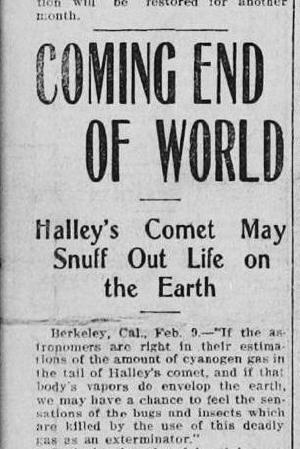Blog
Signs and Portents
20 May 2014
 Bayeux Tapestry
Bayeux TapestryIn 1066 a comet appeared in the sky, larger than Venus, and unusually bright. Like many comets, its appearance was taken as an omen. This happened to be the same year as the Battle of Hastings, in which the Anglo-Saxon King Harold II clashed with Duke William II of Normandy in a battle which sealed the Norman conquest of England. After the battle it became clear that the comet was an omen of William the Conqueror’s victory, which is commemorated in the Bayeux Tapestry. The comet is included in the tapestry, as you can see.
Traditionally comets were often seen as omens. Sometimes good, often bad, and sometimes both depending on your point of view, as in the 1066 comet. Aristotle held that comets were a product of gases that would catch fire in the upper atmosphere, and this view generally held until the 1500s. In 1577 a large and bright comet was observed across Europe, and Tycho Brahe used parallax observations to demonstrate that the comet was outside the orbit of the Moon, likely more than three times the lunar distance. They clearly weren’t a product of the Earth’s atmosphere.
With Newton’s development of the theory of gravity in the late 1600s, many astronomers sought to apply gravity to the motion of comets. In 1705 Edmond Halley demonstrated that the comets of 1531, 1607 and 1682 had nearly identical orbits. He predicted they were, in fact, the same comet, and that it would appear again in 1758. His prediction was a success, which is why it is now known as Halley’s comet. Since then we’ve been able to trace its appearance throughout history, including the Hastings comet of 1066.
 1910 New York Times
1910 New York TimesAfter Halley’s discovery of cometary motion, comets began to be viewed less as omens. But the appearance of Halley’s comet in 1910 gave rise to an apocalyptic scare. By this time astrophotography had been developed, and astronomers were beginning to use spectroscopy to analyze the elements in the Sun and stars. When astronomers looked at the spectrum of Halley’s comet, they identified things like water, carbon monoxide, but also a carbon-nitrogen molecule known as cyanogen. We now refer to it as cyanide. The presence of this poisonous gas was alarming to some, particularly given that the path of Halley’s comet was such that the Earth would pass through its tail.
While most astronomers thought this was not a big deal, but there was one particular astronomer who disagreed. Nicolas Camille Flammarion was well known at the time for his popular science writing, science fiction novels, and work on spiritualism. When interviewed by the New York Times, he was quoted as saying the cyanogen “would impregnate the atmosphere and possibly snuff out all life on the planet.” Needless to say this bit of sensationalism by a popular scientist created quite a stir. Gas masks were sold, comet pills were proffered, and church attendance was on the rise.
Of course when Earth passed through Halley’s tail, nothing happened. No one was poisoned, and the world didn’t end.
You’ve often heard me complain about sensationalism in science reporting. The signs and portents of hype, if you will. Needless to say, it’s been going on for quite a long time.